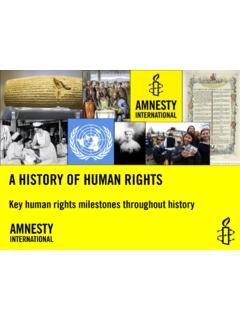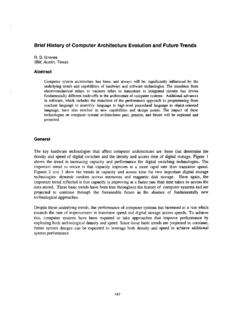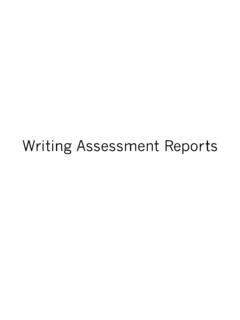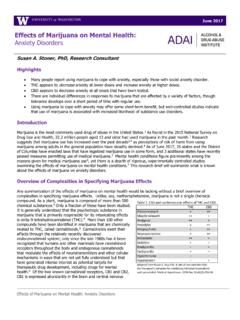Transcription of The factors associated with proven re-offending following ...
1 Revision to The factors associated with proven re- offending following release from prison : findings from Waves 1 to 3 of SPCR Wave 3: Post- release resettlement experience, Section , p. 19 A sentence on page 19: approximately 66% went on to re-offend, compared with 51% of those who were not living with immediate family members has been corrected to: approximately 66% went on to re-offend, compared with 51% of those living in stable accommodation . Any enquiries should be directed to the Ministry of Justice at: The factors associated with proven re- offending following release from prison : findings from Waves 1 to 3 of SPCR Results from the Surveying Prisoner Crime Reduction (SPCR) longitudinal cohort study of prisoners) Ian Brunton-Smith, University of Surrey and Kathryn Hopkins, Ministry of Justice Ministry of Justice Analytical Series 2013 Analytical Services exists to improve policy making, decision taking and practice by the Ministry of Justice.
2 It does this by providing robust, timely and relevant data and advice drawn from research and analysis undertaken by the department s analysts and by the wider research community. Disclaimer The views expressed are those of the authors and are not necessarily shared by the Ministry of Justice (nor do they represent Government policy). First published 2013 Crown copyright 2013 You may re-use this information (excluding logos) free of charge in any format or medium, under the terms of the Open Government Licence. To view this licence, visit or email: Where we have identified any third party copyright material you will need to obtain permission from the copyright holders concerned. Any enquiries regarding this publication should be sent to us at This publication is available for download at ISBN 978-1-84099-617-3 Acknowledgements SPCR was funded by the Home Office, the Ministry of Justice, the Department of Work and Pensions, the Department of Health and the Department for Innovation, Universities and Skills (now the Department for Business, Innovation and Skills).
3 Thanks are due to Ipsos MORI, whose staff collected the data for this research. Special thanks are due to the prisoners who participated in this survey, and governors and staff at participating prisons. Thanks are also extended to colleagues in Offender Management and Sentencing Analytical Services, the National Offender Management Service and the Ministry of Justice, all of whom contributed to this report. Thanks also to James Carpenter, Mike Kenward and Roger Tarling for their work on missing data at Wave 2 and Wave 3 of SPCR. Contents List of tables List of figures 1. Summary 1 2. Context 6 Background 6 Aims 7 3. Approach 8 4. Results 12 factors associated with re- offending 12 Multivariate results: the final logistic regression model 20 5.
4 Conclusion and implications 28 References 30 Annex A 34 A SPCR Sample 1 prevalence of factors associated with re- offending on release and comparisons with the general population 34 List of tables Table : SPCR re- offending sample: by gender, age, ethnic background (two groupings), sentence length, and offence type 13 Table : SPCR re- offending sample: experiences in prison and association with re- offending one year after release (MI adjusted results) 16 Table : SPCR re- offending sample (pre-custody drug or alcohol users only): drug/alcohol interventions in prison and association with re- offending one year after release (MI adjusted results) 17 Table : SPCR re- offending sample: other prison -based interventions and association with re- offending one year after release (MI adjusted results) 18 Table : SPCR re- offending sample: resettlement experience and association with re- offending one year after release (MI adjusted results) 20 Table : SPCR re- offending sample: factors independently associated with re- offending in 1 and 2 years (MI adjusted results) 23 Table : SPCR Sample 1: prevalence of background (Wave 1) factors associated with re- offending on release 34 Table : General population: prevalence of some similar background factors to those reported by SPCR Sample 1 in Table 35 List of figures Figure : SPCR interviews and topic areas/life stages 1 1.
5 Summary Increasing our understanding of prisoners who re-offend after release is a key priority for the development of policy in relation to the management and rehabilitation of offenders. Between 2005 and 2010 a longitudinal cohort study (Surveying Prisoner Crime Reduction SPCR) was conducted to improve the evidence in this area. This study involved interviews during and after custody,1 as well as matching individuals to administrative data such as criminal Interviews gathered information about a wide range of prisoners needs, experiences and behaviours at different life stages. Topics included childhood, schooling and family issues, prior offending , drug use, mental health, and accommodation and employment before and after custody. The study also asked about experiences and behaviour in prison , including participation in interventions (such as offender behaviour programmes), work, family visits, drug use and punishments received in prison .
6 Figure provides a schematic outline of interview topics and timing. Figure : SPCR interviews and topic areas/life stages Childhood / early life Before custody During custody Post release Information was gathered about prisoners experiences at different phases Interviews were carried out during and after custody Previous reports from the SPCR study have focused on the background characteristics of prisoners, including childhood experiences, education, employment, drug and alcohol use, health and mental health, needs and attitudes, accommodation before custody, and criminal history (MoJ, 2010a; Light et al, 2013; Williams et al, 2012a; 2012b; Hopkins 2012; Boorman & Hopkins 2012) These reports were based on bivariate analysis and explored prevalence of 1 The current report uses self-report data from Waves 1 to 3 of the survey ( prison reception, pre- release , post release interviews) and is based on SPCR Sample 1, which includes 1,435 adult prisoners sentenced to between one month and four years in England and Wales in 2005 and 2006.
7 2 Approximately 93% of the sample was matched to the Police National Computer (PNC), allowing re- offending and criminal history analyses to be undertaken and this sub-sample of 1,331 prisoners was representative of reception prisoners. 1 these pre-custody factors and whether they were associated with higher rates of re- offending on release . The current report extends this approach, first using bivariate analysis to describe a range of experiences and behaviours during custody and post release , exploring how re- offending rates vary according to these later factors . The analysis then focuses more specifically on identifying the particular aspects of offenders experiences before, during and shortly after prison that were most strongly associated with higher likelihood of re- offending after release . To do so the analysis used logistic regression, developing a multivariate model to allow several factors to be tested for their association with re- offending at the same time.
8 This allows us to demonstrate which factors were independently associated with re- offending , when all factors were considered together. Logistic regression analysis does not establish causal links between events, circumstances and re- offending . Nevertheless, the approach allows us to identify a range of factors directly associated with re- offending , and to consider the relative importance of different factors to support policy makers and practitioners working with prisoners and ex-prisoners. findings The analysis identified a number of factors as independently associated with re- offending after release . These related to: Prior offending Drug use, accommodation and employment in the community In- prison attitudes and behaviour Regular truancy from school in childhood Key conclusions and implications are set out below. 2 offending In line with previous research ( May et al.)
9 , 2008; MoJ, 2012a) previous offending history was found to be the most important factor in predicting re- offending . Offenders who had a more complex offending history (as measured by their Copas rates3) were more likely to be reconvicted on release . In contrast, offenders serving their first prison sentence were less likely to be reconvicted. Crime type was identified in the analysis as an important predictor, in particular offenders who were serving a sentence for an acquisitive crime (theft, robbery, prostitution, handling stolen goods, burglary) were more likely to go on to re-offend than offenders serving sentences for other crime types (for example, violence, sexual offences, drug offences, fraud and forgery, vehicle-related offences, and other offences). Behaviour and experiences in the community Criminogenic needs experienced in the community before or after custody, such as insecure accommodation, employment needs and substance misuse were identified as good predictors, even after controlling for criminal history , reinforcing the importance of interventions to address these issues in order to reduce re- offending .
10 Specifically: Offenders who were homeless or living in temporary accommodation prior to their prison sentence were more likely to re-offend on release than those with more stable accommodation. Offenders who reported Class A drug use after custody were more likely to re-offend than those who did not. Prisoners who reported being employed at some point in the 12 months before custody were less likely to re-offend than those who had not been employed during the same period. In-custody behaviours and experiences The analysis also found that offenders who were less willing to follow prison rules (that is, those who received additional punishment while in prison ) were more likely to re-offend, after controlling for other factors ; this suggests that there may be opportunity to identify and target a group of offenders for further engagement to reduce re- offending .
















